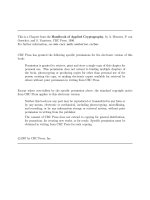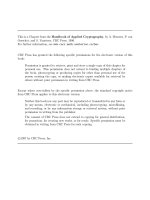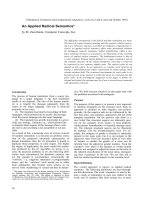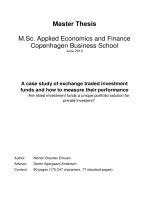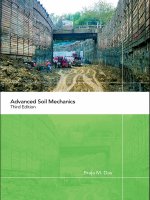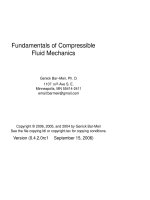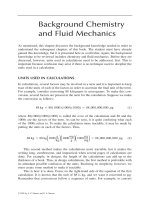Applied Biofluid Mechanics doc
Bạn đang xem bản rút gọn của tài liệu. Xem và tải ngay bản đầy đủ của tài liệu tại đây (5.65 MB, 333 trang )
Applied Biofluid
Mechanics
This page intentionally left blank
Applied Biofluid
Mechanics
Lee Waite, Ph.D., P.E.
Jerry Fine, Ph.D.
New York Chicago San Francisco Lisbon London Madrid
Mexico City Milan New Delhi San Juan Seoul
Singapore Sydney Toronto
Copyright © 2007 by The McGraw-Hill Companies, Inc. All rights reserved. Manufactured in the United
States of America. Except as permitted under the United States Copyright Act of 1976, no part of this pub-
lication may be reproduced or distributed in any form or by any means, or stored in a database or retrieval
system, without the prior written permission of the publisher.
0-07-150951-8
The material in this eBook also appears in the print version of this title: 0-07-147217-7.
All trademarks are trademarks of their respective owners. Rather than put a trademark symbol after every
occurrence of a trademarked name, we use names in an editorial fashion only, and to the benefit of the trade-
mark owner, with no intention of infringement of the trademark. Where such designations appear in this
book, they have been printed with initial caps.
McGraw-Hill eBooks are available at special quantity discounts to use as premiums and sales promotions,
or for use in corporate training programs. For more information, please contact George Hoare, Special Sales,
at or (212) 904-4069.
TERMS OF USE
This is a copyrighted work and The McGraw-Hill Companies, Inc. (“McGraw-Hill”) and its licensors reserve
all rights in and to the work. Use of this work is subject to these terms. Except as permitted under the
Copyright Act of 1976 and the right to store and retrieve one copy of the work, you may not decompile, dis-
assemble, reverse engineer, reproduce, modify, create derivative works based upon, transmit, distribute, dis-
seminate, sell, publish or sublicense the work or any part of it without McGraw-Hill’s prior consent. You may
use the work for your own noncommercial and personal use; any other use of the work is strictly prohibited.
Your right to use the work may be terminated if you fail to comply with these terms.
THE WORK IS PROVIDED “AS IS.” McGRAW-HILL AND ITS LICENSORS MAKE NO GUARAN-
TEES OR WARRANTIES AS TO THE ACCURACY, ADEQUACY OR COMPLETENESS OF OR
RESULTS TO BE OBTAINED FROM USING THE WORK, INCLUDING ANY INFORMATION THAT
CAN BE ACCESSED THROUGH THE WORK VIA HYPERLINK OR OTHERWISE, AND EXPRESSLY
DISCLAIM ANY WARRANTY, EXPRESS OR IMPLIED, INCLUDING BUT NOT LIMITED TO
IMPLIED WARRANTIES OF MERCHANTABILITY OR FITNESS FOR A PARTICULAR PURPOSE.
McGraw-Hill and its licensors do not warrant or guarantee that the functions contained in the work will meet
your requirements or that its operation will be uninterrupted or error free. Neither McGraw-Hill nor its licen-
sors shall be liable to you or anyone else for any inaccuracy, error or omission, regardless of cause, in the
work or for any damages resulting therefrom. McGraw-Hill has no responsibility for the content of any infor-
mation accessed through the work. Under no circumstances shall McGraw-Hill and/or its licensors be liable
for any indirect, incidental, special, punitive, consequential or similar damages that result from the use of or
inability to use the work, even if any of them has been advised of the possibility of such damages. This lim-
itation of liability shall apply to any claim or cause whatsoever whether such claim or cause arises in con-
tract, tort or otherwise.
DOI: 10.1036/0071472177
ABOUT THE AUTHORS
LEE WAITE, PH.D., P.E., is Head of the Department of
Applied Biology and Biomedical Engineering, and Director
of the Guidant/Eli Lilly and Co. Applied Life Sciences
Research Center, at Rose-Hulman Institute of Technology in
Terre Haute, Indiana. He is also the author of Biofluid
Mechanics in Cardiovascular Systems, published by
McGraw-Hill.
J
ERRY FINE, PH.D., is Associate Professor of Mechanical
Engineering at Rose-Hulman Institute of Technology.
Before he joined the faculty at Rose, Dr. Fine served as
a patrol plane pilot in the U.S. Navy and taught at the
U.S. Naval Academy.
Copyright © 2007 by The McGraw-Hill Companies, Inc. Click here for terms of use.
This page intentionally left blank
vii
Contents
Preface xiii
Acknowledgments xv
Chapter 1. Review of Basic Fluid Mechanics Concepts 1
1.1 A Brief History of Biomedical Fluid Mechanics 1
1.2 Fluid Characteristics and Viscosity 6
1.2.1 Displacement and velocity 7
1.2.2 Shear stress and viscosity 8
1.2.3 Example problem: shear stress 10
1.2.4 Viscosity 11
1.2.5 Clinical feature: polycythemia 13
1.3 Fundamental Method for Measuring Viscosity 14
1.3.1 Example problem: viscosity measurement 16
1.4 Introduction to Pipe Flow 16
1.4.1 Reynolds number 17
1.4.2 Example problem: Reynolds number 19
1.4.3 Poiseuille’s law 19
1.4.4 Flow rate 23
1.5 Bernoulli Equation 24
1.6 Conservation of Mass 24
1.6.1 Venturi meter example 26
1.7 Fluid Statics 27
1.7.1 Example problem: fluid statics 28
1.8 The Womersley Number α: A Frequency Parameter for Pulsatile Flow 29
1.8.1 Example problem: Womersley number 30
Problems 31
Bibliography 33
Chapter 2. Cardiovascular Structure and Function 35
2.1 Introduction 35
2.2 Clinical Features 36
2.3 Functional Anatomy 37
2.4 The Heart as a Pump 38
2.5 Cardiac Muscle 39
2.5.1 Biopotential in myocardium 40
For more information about this title, click here
2.5.2 Excitability 41
2.5.3 Automaticity 43
2.6 Electrocardiograms 43
2.6.1 Electrocardiogram leads 44
2.6.2 Mean electrical axis 45
2.6.3 Example problem: mean electrical axis 47
2.6.4 Unipolar versus bipolar and augmented leads 48
2.6.5 Electrocardiogram interpretations 49
2.6.6 Clinical feature: near maximal exercise stress test 50
2.7 Heart Valves 51
2.7.1 Clinical features 52
2.8 Cardiac Cycle 52
2.8.1 Pressure-volume diagrams 55
2.8.2 Changes in contractility 57
2.8.3 Ventricular performance 58
2.8.4 Clinical feature: congestive heart failure 58
2.8.5 Pulsatility index 59
2.8.6 Example problem: pulsatility index 59
2.9 Heart Sounds 60
2.9.1 Clinical features 61
2.9.2 Factors influencing flow and pressure 61
2.10 Coronary Circulation 63
2.10.1 Control of the coronary circulation 64
2.10.2 Clinical features 65
2.11 Microcirculation 65
2.11.1 Capillary structure 65
2.11.2 Capillary wall structure 66
2.11.3 Pressure control in the microvasculature 67
2.11.4 Diffusion in capillaries 68
2.11.5 Venules 68
2.12 Lymphatic Circulation 69
Problems 69
Bibliography 75
Chapter 3. Pulmonary Anatomy, Pulmonary Physiology,
and Respiration 77
3.1 Introduction 77
3.1.1 Clinical features: hyperventilation 78
3.2 Alveolar Ventilation 79
3.2.1 Tidal volume 79
3.2.2 Residual volume 79
3.2.3 Expiratory reserve volume 80
3.2.4 Inspiratory reserve volume 80
3.2.5 Functional residual capacity 80
3.2.6 Inspiratory capacity 80
3.2.7 Total lung capacity 80
3.2.8 Vital capacity 81
3.3 Ventilation-Perfusion Relationships 81
3.4 Mechanics of Breathing 81
3.4.1 Muscles of inspiration 82
3.4.2 Muscles of expiration 83
3.4.3 Compliance of the lung and chest wall 83
viii Contents
3.4.4 Elasticity, elastance, and elastic recoil 83
3.4.5 Example problem: compliance 84
3.5 Work of Breathing 85
3.5.1 Clinical features: respiratory failure 87
3.6 Airway Resistance 88
3.6.1 Example problem: Reynolds number 91
3.7 Gas Exchange and Transport 91
3.7.1 Diffusion 92
3.7.2 Diffusing capacity 92
3.7.3 Oxygen dissociation curve 94
3.7.4 Example problem: oxygen content 95
3.7.5 Clinical feature 96
3.8 Pulmonary Pathophysiology 96
3.8.1 Bronchitis 96
3.8.2 Emphysema 96
3.8.3 Asthma 97
3.8.4 Pulmonary fibrosis 98
3.8.5 Chronics obstructive pulmonary disease (COPD) 98
3.8.6 Heart disease 98
3.8.7 Comparison of pulmonary pathologies 98
3.9 Respiration in Extreme Environments 99
3.9.1 Barometric pressure 100
3.9.2 Partial pressure of oxygen 101
3.9.3 Hyperventilation and the alveolar gas equation 102
3.9.4 Alkalosis 103
3.9.5 Acute mountain sickness 103
3.9.6 High-altitude pulmonary edema 104
3.9.7 High-altitude cerebral edema 104
3.9.8 Acclimatization 104
3.9.9 Drugs stimulating red blood cell production 105
3.9.10 Example problem: alveolar gas equation 106
Review Problems 106
Bibliography 109
Chapter 4. Hematology and Blood Rheology 111
4.1 Introduction 111
4.2 Elements of Blood 111
4.3 Blood Characteristics 111
4.3.1 Types of fluids 112
4.3.2 Viscosity of blood 113
4.3.3 Fåhræus-Lindqvist effect 114
4.3.4 Einstein’s equation 116
4.4 Viscosity Measurement 116
4.4.1 Rotating cylinder viscometer 116
4.4.2 Measuring viscosity using Poiseuille’s law 118
4.4.3 Viscosity measurement by a cone and plate viscometer 119
4.5 Erythrocytes 121
4.5.1 Hemoglobin 123
4.5.2 Clinical features—sickle cell anemia 125
4.5.3 Erythrocyte indices 125
4.5.4 Abnormalities of the blood 126
4.5.5 Clinical feature—thalassemia 127
Contents ix
4.6 Leukocytes 127
4.6.1 Neutrophils 128
4.6.2 Lymphocytes 129
4.6.3 Monocytes 131
4.6.4 Eosinophils 131
4.6.5 Basophils 131
4.6.6 Leukemia 131
4.6.7 Thrombocytes 132
4.7 Blood Types 132
4.7.1 Rh blood groups 134
4.7.2 M and N blood group system 135
4.8 Plasma 135
4.8.1 Plasma viscosity 136
4.8.2 Electrolyte composition of plasma 136
4.8.3 Blood pH 137
4.8.4 Clinical features—acid–base imbalance 137
Review Problems 138
Bibliography 139
Chapter 5. Anatomy and Physiology of Blood Vessels 141
5.1 Introduction 141
5.2 General Structure of Arteries 141
5.2.1 Tunica intima 142
5.2.2 Tunica media 142
5.2.3 Tunica externa 143
5.3 Types of Arteries 144
5.3.1 Elastic arteries 144
5.3.2 Muscular arteries 144
5.3.3 Arterioles 144
5.4 Mechanics of Arterial Walls 144
5.5 Compliance 147
5.5.1 Compliance example 151
5.5.2 Clinical feature—arterial compliance and hypertension 152
5.6 Pulse Wave Velocity and the Moens–Korteweg Equation 153
5.6.1 Applications box—fabrication of arterial models 153
5.6.2 Pressure–strain modulus 153
5.6.3 Example problem—modulus of elasticity 154
5.7 Vascular Pathologies 155
5.7.1 Atherosclerosis 155
5.7.2 Stenosis 155
5.7.3 Aneurysm 156
5.7.4 Clinical feature—endovascular aneurysm repair 156
5.7.5 Thrombosis 157
5.8 Stents 157
5.8.1 Clinical feature—“Stent Wars” 158
5.9 Coronary Artery Bypass Grafting 159
5.9.1 Arterial grafts 160
Review Problems 161
Bibliography 162
x Contents
Contents xi
Chapter 6. Mechanics of Heart Valves 165
6.1 Introduction 165
6.2 Aortic and Pulmonic Valves 165
6.2.1 Clinical feature—percutaneous aortic valve implantation 169
6.3 Mitral and Tricuspid Valves 171
6.4 Pressure Gradients across a Stenotic Heart Valve 172
6.4.1 The Gorlin equation 173
6.4.2 Example problem—Gorlin equation 175
6.4.3 Energy loss across a stenotic valve 175
6.4.4 Example problem—energy loss method 178
6.4.5 Clinical features 178
6.5 Prosthetic Mechanical Valves 178
6.5.1 Clinical feature—performance of the On-X valve 180
6.5.2 Case study—the Björk-Shiley convexo-concave heart valve 180
6.6 Prosthetic Tissue Valves 184
Review Problems 184
Bibliography 185
Chapter 7. Pulsatile Flow in Large Arteries 187
7.1 Introduction 187
7.2 Fluid Kinematics 188
7.3 Continuity 189
7.4 Complex Numbers 190
7.5 Fourier Series Representation 192
7.6 Navier–Stokes Equations 198
7.7 Pulsatile Flow in Rigid Tubes—Womersley Solution 202
7.8 Pulsatile Flow in Rigid Tubes—Fry Solution 214
7.9 Instability in Pulsatile Flow 221
Review Problems 222
Bibliography 227
Chapter 8. Flow and Pressure Measurement 229
8.1 Introduction 229
8.2 Indirect Pressure Measurements 229
8.2.1 Indirect pressure gradient measurements using
Doppler ultrasound 230
8.3 Direct Pressure Measurement 231
8.3.1 Intravascular—strain gauge tipped pressure transducer 231
8.3.2 Extravascular—catheter-transducer measuring system 237
8.3.3 Electrical analog of the catheter measuring system 238
8.3.4 Characteristics for an extravascular pressure
measuring system 240
8.3.5 Example problem—characteristics of an extravascular
measuring system 241
8.3.6 Case 1: the undamped catheter measurement system 243
8.3.7 Case 2: the undriven, damped catheter measurement system 244
8.3.8 Pop test—measurement of transient step response 248
8.4 Flow Measurement 249
8.4.1 Indicator dilution method 249
8.4.2 Fick technique for measuring cardiac output 250
8.4.3 Fick technique example 250
8.4.4 Rapid injection indicator-dilution method—
dye dilution technique 250
8.4.5 Thermodilution 251
8.4.6 Electromagnetic flowmeters 252
8.4.7 Continuous wave ultrasonic flowmeters 253
8.4.8 Example problem—continuous wave Doppler ultrasound 254
8.5 Summary and Clinical Applications 255
Review Problems 256
Bibliography 258
Chapter 9. Modeling 259
9.1 Introduction 259
9.2 Theory of Models 260
9.2.1 Dimensional analysis and the Buckingham Pi theorem 260
9.2.2 Synthesizing Pi terms 262
9.3 Geometric Similarity 264
9.4 Dynamic Similarity 265
9.5 Kinematic Similarity 265
9.6 Common Dimensionless Parameters in Fluid Mechanics 266
9.7 Modeling Example 1—Does the Flea Model the Man? 266
9.8 Modeling Example 2 268
9.9 Modeling Example 3 269
Review Problems 271
Bibliography 273
Chapter 10. Lumped Parameter Mathematical Models 275
10.1 Introduction 275
10.2 Electrical Analog Model of Flow in a Tube 276
10.2.1 Nodes and the equations at each node 277
10.2.2 Terminal load 278
10.2.3 Summary of the lumped parameter electrical analog model 288
10.3 Modeling of Flow through the Mitral Valve 288
10.3.1 Model description 289
10.3.2 Active ventricular relaxation 292
10.3.3 Meaning of convective resistance 292
10.3.4 Variable area mitral valve model description 292
10.3.5 Variable area mitral valve model parameters 293
10.3.6 Solving the system of differential equations 294
10.3.7 Model trials 294
10.3.8 Results 294
10.4 Summary 296
Review Problems 297
Bibliography 297
Index 299
xii Contents
xiii
Preface
Biomedical engineering is a discipline that is multidisciplinary by
definition. The days when medicine was left to the physicians, and
engineering was left to the engineers, seem to have passed us by. I
have searched for an undergraduate/graduate level biomedical fluid
mechanics textbook since I began teaching at Rose-Hulman in 1987. I
looked for, but never found, a book that combined the physiology of the
cardiovascular and pulmonary systems with engineering of fluid
mechanics and hematology to my satisfaction, so I agreed to write a mono-
graph. Ken McCombs at McGraw-Hill was satisfied well enough with
that work that he asked me to write the textbook version that you see
here. Applied Biofluid Mechanics includes problem sets and a solutions
manual that traditionally accompany engineering textbooks.
Applied Biofluid Mechanics begins in Chapter 1 with a review of some
of the basics of fluid mechanics, which all mechanical or chemical engi-
neers would learn. It continues with two chapters on cardiovascular and
pulmonary physiology followed by a chapter describing hematology and
blood rheology. These five chapters provide the foundation for the remain-
der of the book, which focuses on more advanced engineering concepts.
Dr. Fine has added some particularly nice improvements in Chapters 7
and 10 concerning solutions for, and modeling of, pulsatile flow.
My 10-week, graduate-level, biofluid mechanics course forms the basis
for the book. The course consists of 40 lectures and covers most, but not
all, of the material contained in the book. The course is intended to pre-
pare students for work in the health care device industry and others for
graduate work in biomedical engineering.
In spite of great effort on the part of many proofreaders, I expect that
mistakes will appear in this book. I welcome suggestions for improvement
from all readers, with intent to improve subsequent printings and editions.
L
EE WAITE, PH.D., P.E.
Copyright © 2007 by The McGraw-Hill Companies, Inc. Click here for terms of use.
This page intentionally left blank
Acknowledgments
I would like to thank my BE525 students from fall term of 2006, who
through their proofreading helped to improve this book, Applied Biofluid
Mechanics. I wish to thank Steve Chapman and the editorial and pro-
duction staff at McGraw-Hill for their assistance.
Special thanks go to my friend and co-author Dr. Jerry Fine, without
whom it would have been extremely difficult to meet the agreed-upon
deadlines for this book. Dr. Fine is especially responsible for significant
improvements in Chapters 7 and 10.
Jerry would like to give a special acknowledgment to his father,
Dr. Neil C. Fine, for his encouragement over the years, and for being a
superb example of a life-long learner.
Thanks once again to the faculty in the Applied Biology and Biomedical
Engineering Department at Rose-Hulman for their counsel and for put-
ting up with a department head who wrote a book instead of giving full
concentration to departmental issues.
In writing this book I have been keenly aware of the debt I owe to Don
Young, my dissertation advisor at Iowa State, who taught me much of
what I know about biomedical fluid mechanics.
Most of all I would like to thank my colleague, wife, and best friend
Gabi Nindl Waite, who put up with me during the long evening hours
and long weekends that it took to write this book. Thanks especially for
everything you taught me about physiology.
L
EE WAITE, PH.D., P.E.
xv
Copyright © 2007 by The McGraw-Hill Companies, Inc. Click here for terms of use.
This page intentionally left blank
Applied Biofluid
Mechanics
This page intentionally left blank
Chapter
1
Review of Basic Fluid
Mechanics Concepts
1.1 A Brief History of Biomedical
Fluid Mechanics
People have written about the circulation of blood for thousands of years.
I include here a short history of biomedical fluid mechanics, because I
believe it is important to recognize that, in all of science and engineer-
ing, we “stand on the shoulders of giants.”
1
In addition, it is interesting
information in its own right. Let us begin the story in ancient times.
The Yellow Emperor, Huang Ti, lived in China from about 2700 to
2600 BC and, according to legend, wrote one of the first works dealing
with circulation. Huang Ti is credited with writing Internal Classics,
in which fundamental theories of Chinese medicine were addressed,
although most Chinese scholars believe it was written by anonymous
authors in the Warring Period (475–221 BC). Among other topics,
Internal Classics includes the Yin-Yang doctrine and the theory of
circulation.
Hippocrates (Fig. 1.1), who lived in Greece around 400 BC, is consid-
ered by many to be the father of science-based medicine and was the first
to separate medicine from magic. Hippocrates declared that the human
body was integral to nature and was something that should be under-
stood. He founded a medical school on the island of Cos, Greece, and
developed the Oath of Medical Ethics.
1
1
“If I have seen further (than others), it is by standing on the shoulders of giants.” This
was written by Isaac Newton in a letter to Robert Hooke, 1675.
Copyright © 2007 by The McGraw-Hill Companies, Inc. Click here for terms of use.
Aristotle, a highly influential early scientist and philosopher, lived in
Greece between 384 and 322 BC. He wrote that the heart was the focus
of blood vessels, but did not make a distinction between arteries and
veins.
Praxagoras of Cos was a Greek physician and a contemporary of
Aristotle. Praxagoras wasapparently the first Greek physician to recognize
the difference between arteries (carriers of air, as he thought) and veins
(carriers of blood), and to comment on the pulse.
The reasoning behind arteries as carriers of air makes sense when you
realize that, in a cadaver, the blood tends to pool in the more flexible
veins, leaving the stiffer arteries empty.
In this book, we will also consider the mechanics of breathing at high
altitudes, in the discussion of biomedical fluid mechanics. Let us turn our
history in that direction. It is thought that Aristotle (384–322 BC) was
aware that the air is “too thin for respiration” on top of high mountains.
2 Chapter One
Figure 1.1 Hippocrates. Courtesy of the National Library of
Medicine Images from the History of Medicine, B029254.
Francis Bacon (1561–1626) in his Novum Organun, which appeared in
1620, includes the following statement (Bacon, 1620, pp. 358–360) from
an English translation of the Latin text. “The ancients also observed,
that the rarity of the air on the summit of Olympus was such that those
who ascended it were obliged to carry sponges moistened with vinegar
and water, and to apply them now and then to their nostrils, as the air
was not dense enough for their respiration.”
There is much evidence that the ancients seem to have known some-
thing about the mechanics of respiration at high altitudes. The following
colorful description of mountain sickness comes from a classical Chinese
history of the period preceding the Han dynasty, the Ch’ien Han Shu. The
Chinese text is from Pan Ku (AD 32–92), and the English translation is
from Alexander Wylie (1881) as appears in John West’s High Life (1998).
Speaking of a journey through the mountains, the text comments:
Again, on passing the Great Headache Mountain, the Little Headache
Mountain, the Red Land, and the Fever Slope, men’s bodies become fever-
ish, they lose color, and are attached with headache and vomiting; the
asses and cattle being all in like condition. Moreover there are three pools
with rocky banks along which the pathway is only 16 or 17 inches wide for
a length of some 30 le, over an abyss
The first description of high-altitude pulmonary edema appeared
some 400 years later. Fˆa-hien was a Chinese Buddhist monk who under-
took an amazing trip through western China, Sinkiang, Kashmir,
Afghanistan, Pakistan, and northern India to Calcutta by foot. He con-
tinued the trip by boat to Sri Lanka and then on to Indonesia and finally
to the China Sea ending in Nanjing. The journey took 15 years from
AD 399 to 414. While crossing the “Little Snowy Mountains” in
Afghanistan, his companion became ill.
Having stayed there till the third month of winter, Fˆa-hien and two
others, proceeding southward, crossed the Little Snowy Mountains, on
which the snow lies accumulated both in winter and in summer. On the
northern side of the mountains, in the shade, they suddenly encountered
a cold wind which made them shiver and become unable to speak. Hwuy-
king could not go any further. White froth came down from his mouth,
and he said to Fˆa-hien, “I cannot live any longer. Do you immediately
go away, that we do not all die here.” With these words, he died. Fˆa-hien
stroked the corpse and cried out piteously, “Our original plan has failed;
it is fate. What can we do?”
Father Joseph de Acosta (1540–1600) was a Spanish Jesuit priest who
left Spain and traveled to Peru in about 1570. He wrote the book Historia
Natural y Moral de las Indias, which was first published in Seville in
Spanish in 1590. Acosta had become a Jesuit priest at the age of 13. As
he left Spain, he traveled across the Atlantic to Nombre de Dios, a town
on the Atlantic coast of Panama, near the mouth of the Río Chagres, near
Review of Basic Fluid Mechanics Concepts 3
Colon, and then journeyed through 18 leagues of tropical forest to
Panama. West writes
From Panama he embarked for Peru with some apprehension because the
ancient philosophers had taught that the equator was in the “burning
zone” where the heat was unbearable. However he crossed the equator in
March, and to his surprise, it was so cold that he was forced to go into the
sun to get warm, where he laughed at Aristotle and his philosophy.
See Fig. 1.2. (Acosta, 1604, p. 90.)
On visiting a Peruvian mountain, which he called, “Pariacaca,” which
is thought by some to be the mountain called today Tullujuto, Acosta wrote
For my part I holde this place to be one of the highest parts of land in
the worlde; for we mount a wonderfull space. And in my opinion, the
mountaine Nevade of Spaine, the Pirenees, and the Alpes of Italie, are as
ordinarie houses, in regard of hie Towers. I therefore perswade my selfe, that
the element of the aire is there so subtile and delicate as it is not propor-
tionable with the breathing of man, which requires a more grosse and tem-
perate aire, and I beleeve it is the cause that doth so much alter the
stomacke, & trouble all the disposition.
This account of mountain sickness and the thinness of the air at high
altitudes is perhaps the most famous from this time period (Acosta,
1604, Chapter 9, pp. 147–148).
4 Chapter One
Figure 1.2 Authors: Lee Waite and Jerry Fine, on the equator in
Ecuador (Mt. Cayambe, 5790 m, near the highest point on the
equator), agreeing with Father Joseph de Acosta who laughed,
400 years earlier, over Aristotle’s prediction of unbearable heat in
the “burning zone.”
The culmination of our history is the story of how the circulation of
blood was discovered. William Harvey (Fig. 1.3) was born in Folkstone,
England, in 1578. He earned a BA degree from Cambridge in 1597 and
went on to study medicine in Padua, Italy, where he received his doc-
torate in 1602. Harvey returned to England to open a medical practice
and married Elizabeth Brown, daughter of the court physician to Queen
Elizabeth I and King James I. Harvey eventually became the court
physician to King James I and King Charles I.
In 1628, Harvey published, “An anatomical study of the motion of the
heart and of the blood of animals.” This was the first publication in the
Western World that claimed that blood is pumped from the heart and
recirculated. Up to that point, the common theory of the day was that
food was converted to blood in the liver and then consumed as fuel. To
prove that blood was recirculated and not consumed, Harvey showed,
by calculation, that blood pumped from the heart in only a few minutes
exceeded the total volume of blood contained in the body.
Review of Basic Fluid Mechanics Concepts 5
Figure 1.3 William Harvey. Courtesy of the National Library
of Medicine Images from the History of Medicine, B014191.
Jean Louis Marie Poiseuille was a French physician and physiologist,
born in 1797. Poiseuille studied physics and mathematics in Paris.
Later, he became interested in the flow of human blood in narrow tubes.
In 1838, he experimentally derived and later published Poiseuille’s law.
Poiseuille’s law describes the relationship between flow and pressure
gradient in long tubes with constant cross section. Poiseuille died in
Paris in 1869.
Otto Frank was born in Germany in 1865, and he died in 1944. He
was educated in Munich, Kiel, Heidelberg, Glasgow, and Strasburg. In
1890, Frank published, “Fundamental form of the arterial pulse,” which
contained his “Windkessel theory” of circulation. He became a physician
in 1892 in Leipzig and became a professor in Munich in 1895. Frank per-
fected optical manometers and capsules for the precise measurement of
intracardiac pressures and volumes.
1.2 Fluid Characteristics and Viscosity
A fluid is defined as a substance that deforms continuously under appli-
cation of a shearing stress, regardless of how small the stress is. Blood
is a primary example of a biological fluid. To study the behavior of mate-
rials that act as fluids, it is useful to define a number of important fluid
properties, which include density, specific weight, specific gravity, and
viscosity.
Density is defined as the mass per unit volume of a substance and
is denoted by the Greek character r (rho). The SI units for r are kg/m
3
,
and the approximate density of blood is 1060 kg/m
3
. Blood is slightly
denser than water, and red blood cells in plasma
2
will settle to the
bottom of a test tube, over time, due to gravity.
Specific weight is defined as the weight per unit volume of a sub-
stance. The SI units for specific weight are N/m
3
. Specific gravity s is the
ratio of the weight of a liquid at a standard reference temperature to the
weight of water. For example, the specific weight of mercury S
Hg
ϭ 13.6
at 20ЊC. Specific gravity is a unitless parameter.
Density and specific weight are measures of the “heaviness” of a fluid,
but two fluids with identical densities and specific weights can flow quite
differently when subjected to the same forces. You might ask, “What is
the additional property that determines the difference in behavior?”
That property is viscosity.
6 Chapter One
2
Plasma has a density very close to that of water.
